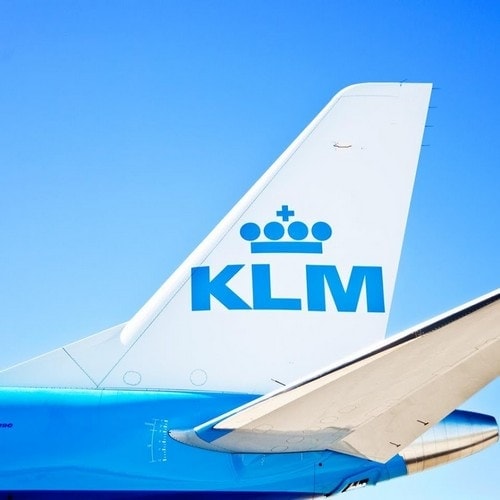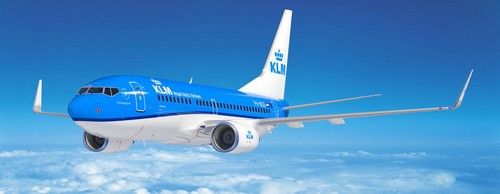KLM Royal Dutch Airlines is a flag carrier airline that was formed during the year 1919 and is headquartered in the Netherlands. This year KLM is celebrating its 100th year anniversary. Originated in Amsterdam, the KLM Group has operated worldwide flights during the year 2018 with a fleet of about 214 aircraft. The airline company has about 33,000 employees and the KLM Group has generated about 10 billion euros in revenue during the year 2018.
KLM Group has about 34.1 million passengers and about 621,000 tons of cargo and that forms the heart of the KLM Group. Having its vast network of about 92 European and 70 intercontinental destinations, KLM airlines provide direct connections to major cities and economic centers across the globe. KLM has partnered with SkyTeam Alliance and provides more options to the travelers by giving an option to about 1063 destinations in 173 countries.
Moreover, the entire subsidiaries Transavia and Martinair are also a part of the KLM Group. An important price fighter in the Netherlands, Transavia operates flights from Amsterdam, Rotterdam, and Eindhoven. KLM has merged with Air France during the year 2004 and operates with the concept of one AIR FRANCE KLM Group, two airlines, and three main activities like Passengers, Engineering & Maintenance, and Airfreight Industry.
By its tie-up with Air France, KLM has a major role in the European aviation industry.
About KLM Royal Dutch Airlines
- Type: Airline.
- Industry: Aviation.
- Founded: 7 October 1919.
- Founders: Albert Plesman and a group of Dutch businessmen.
- Headquarters: Amstelveen, Netherlands.
- Area served: Over 145 destinations in 85 countries.
- Current CEO: Marjan Rintel.
- Number of employees: 35,488.
- Major products: Passenger and cargo transportation.
Through this article, let us discuss the SWOT analysis of KLM.
Table of Contents
Strengths in the SWOT Analysis of KLM
- KLM Network and Alliances – KLM has an excellent partner strategy by having three main building blocks. First, its participation in the joint venture with Air France, Alitalia, and Delta Air Lines. Second, its partnership with Ukraine International Airlines, Kenya Airways, Chinese Southern Airlines, China Eastern Airlines, and Xiamen Airlines. Third, is the broad spectrum of codeshares on each and every continent.
- Strong Image among Customers – KLM has a strong and positive image amongst the customers.
- Code-Sharing Agreement – KLM maintains a code-sharing agreement with many airlines.
- KLM Group – Originated in Amsterdam, the KLM Group has operated worldwide flights during the year 2018 with a fleet of about 214 aircraft. The airline company has about 33,000 employees and the KLM Group has generated about 10 billion euros in revenue during the year 2018. KLM Group has about 34.1 million passengers and about 621,000 tons of cargo and that forms the heart of the KLM Group.
- Vast Network – KLM has its vast network of about 92 European and 70 intercontinental destinations, KLM airlines provide direct connections to major cities and economic centers across the globe.
- Merger with Air France – KLM has merged with Air France during the year 2004 and has become more powerful. It operates with the concept of one AIR FRANCE KLM Group, two airlines, and three main activities like Passengers, Engineering & Maintenance, and Airfreight Industry. By its tie-up with Air France, KLM has a major role in the European aviation industry.
- Entrant into Cargo Business – KLM has entered into the cargo business where it sees a huge business revenue.
- Employees – The airline is proud to have more than 35000 employees working for the airline.
- High Brand Recall – KLM has good advertising and branding and due to which it has made itself to the top brand recall.
- KLM AirCares – KLM has initiated a program for underprivileged children called KLM AirCare. This has helped them to gain more visibility and also carry a good brand image.
Weaknesses in the SWOT Analysis of KLM
- Intense Competition – KLM seems a great competition from other airlines and due to this, it sees a limited market share growth for KLM.
- Accidents – Many past incidents and accidents is a big hurt to the brand image.
- US Market – The airline sees a tough time to occupy in the US Market.
Opportunities in the SWOT Analysis of KLM
- Expansion in Low-Cost Carrier Segment – KLM sees a lot of opportunity in the low-cost carrier segment. Hence expanding its business operations to this segment sees a lot of opportunity to the airline company.
- Efficient Aircraft – Having more efficient aircraft in the development by both Boeing and Airbus will have more passenger capacity and can lead to reduced costs per seat.
- Sustainable Growth Opportunities – KLM sees a huge opportunity to expand its network to more destinations. It can help to gain access to any market that will increase the quality of its network.
Threats in the SWOT Analysis of KLM
- Strong Competitors – KLM sees a lot of competitors in the market. Government bailouts for competitors tend to take the airline to unfair competition. Government interference for any specific issue consolidation is a big threat for the functioning of the airline.
- Available of Local Airlines – Existence of many local airlines that could accommodate short-distance passengers is a threat to the airline. This could affect the business and revenue of KLM.
- Fluctuating Taxes – When there is an increase in environmental concerns, it might lead to higher taxes. This will, in turn, hit the business revenue of the airline.
Liked this post? Check out the complete series on SWOT

